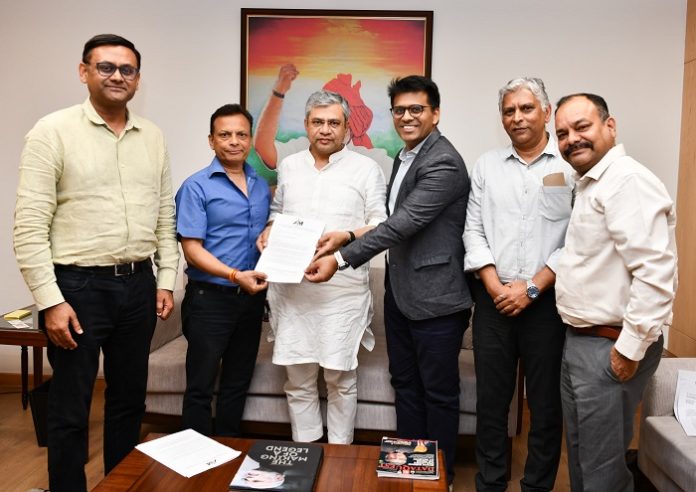
Members of the Association of Indian Magazines (AIM) recently met Ashwini Vaishnaw, Minister of information and broadcasting and railways, to discuss the challenges faced by the Indian magazine industry and to raise their concerns in the face of regulatory and logistical issues.
The meeting followed a memorandum submitted by AIM – a premier industry body representing all major Indian magazine publishers – on 17 April, highlighting their issues with the new legislation and the disruptions in traditional print distribution channels.
Press and Registration of Periodicals Act 2023
The association raised concerns over the Press and Registration of Periodicals (PRP) Act 2023, which defines ‘periodicals’ and ‘newspapers’ as separate categories. The previous PRB Act, 1867, put both newspapers and magazines under the single definition of ‘newspapers,’ which meant “any printed periodical work containing public news or comments on public news.”
Under the new act, however, a newspaper is defined as one that is published and printed at regular intervals, containing public news or comments on public news. The definition does not include books or journals of a scientific, technical, or academic nature.
The AIM members said the new definitions are creating confusion across ministries regarding the eligibility of magazines vis-à-vis the long-established benefits extended to print media. For example, India Post has not renewed the Postal Registration Number of some of AIM’s member publications.
According to AIM, the government has always supported newspapers and magazines, offering the same concessions through various policy measures. These include concessional shipment rates offered by the railways ministry as well as India Post, reduced customs duty on the import of newsprint for newspapers and magazines, the advertising policies under the Central Bureau of Communication and state IPRDs, and the registration of publications under the Registrar of Newspapers in India (RNI).
Magazine distribution issues
Distribution issues were another focal point of the discussion. AIM president and executive publisher at Delhi Press Anant Nath had told Indian Printer & Publisher in an earlier conversation that “the magazine distribution system was getting weaker because newsstands were no longer a viable business. “All of us were facing the problem of the dwindling number of newsstands as the owners were not getting sufficient returns and the general incentives to push the magazines was declining.”
In the past 80 years of Indian magazines, most publishers have relied on newsstand sales for about 90-95% of individual copy sales, with subscriptions amounting to single-digit percentages. Traditionally, railway newsstands contributed a significant percentage of the sales. In recent years, the network of railway magazine stands being run by companies such as AH Wheelers and Higginbothams had completely collapsed.
The association sought the minister’s support in facilitating the sale and availability of magazines in premium trains where IRCTC runs the catering services. The AIM suggested sales through the Indian Railways’ digital platform. It proposed the creation of a magazine store widget on the IRCTC site to boost subscriptions through its extensive user base. A related initiative has also been proposed on the government’s new digital platform, WAVES.
Distribution and logistics costs
The association said that traditionally, magazine publishers have been using railways as the primary mode of dispatch. The railways has always supported magazine publishers in prioritizing magazines over other parcels and by providing subsidies.
A new policy of leasing out seat-cum-luggage rake (SLR) in trains operated by Northern Railways, limiting passenger luggage at normal rates and increasing freight costs have affected magazine publishers. The AIM team urged the ministry to look into the matter and assist publishers in the timely distribution of magazines across the country. They requested the railways ministry to reserve 1,000 kgs for newspapers and magazines in select 18-20 trains commonly used to send magazines.
Subscriptions in schools, colleges and libraries
AIM members proposed encouragement of magazine subscriptions in government-run libraries, schools, and colleges at the village, panchayat and municipal levels, districts, state governments, as well as centrally funded institutions. Magazines, they said, fulfill an important awareness, educational, and entertainment need in the media ecosystem in these institutions.
The AIM members said the National Education Policy 2020 strongly emphasized creating holistic, engaging, and inquiry-based learning environments and the inclusion of magazines in institutional libraries was in direct alignment with the NEP 2020’s vision.
Various states such as Bihar, Tamil Nadu, and Telangana, have an active policy of sanctioning budgets for magazines.
Nath told the IPP Group over a telephonic conversation that over the last few years, magazine publishers were working hard to increase subscriptions and orders from government institutions, public libraries and educational institutions. “We request support from the government in ensuring greater avenues for the growth of magazines from Indian railways, public libraries and educational institutions. The magazine distribution process remains economical through the railways.”
Ashwini Vaishnaw, he said, was receptive to their concerns. Prompt follow-up has been initiated on suggestions for support from the railways, he said, adding they were hopeful of support regarding other policy matters and suggestions.
Through these discussions and suggestive measures, the AIM aims to ensure clarity in the new acts and policies and come up with additional distribution alternatives for the sustained growth of magazines.
The association represents more than over 40 magazine publishers with more than 300 publications across 10 languages, reaching over 150 million Indians across print, digital and social media. AIM members include top publishers such as the India Today Group, Delhi Press, Outlook Group, Malayala Manorama Publishing, Vikatan Group and Cybermedia. The association aims to support and defend the freedom of the press and promote the cause of magazines.


















The concerns about logistics and distribution really resonate, especially with the post-pandemic shift in media consumption. Addressing these operational issues is essential if we want to preserve diverse voices in print media.